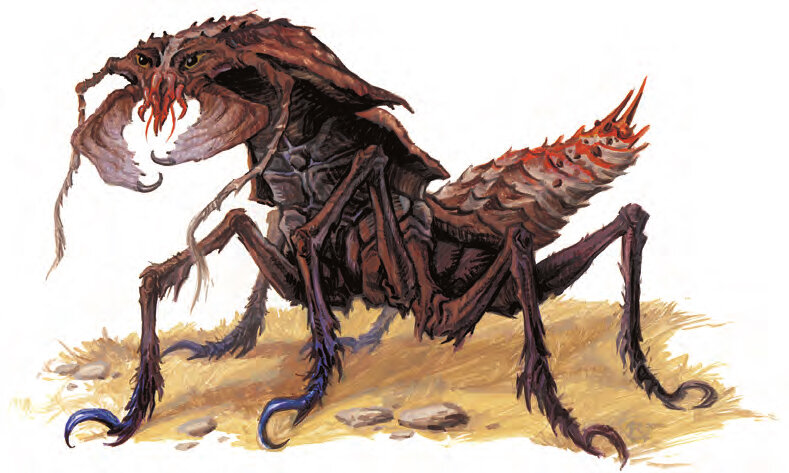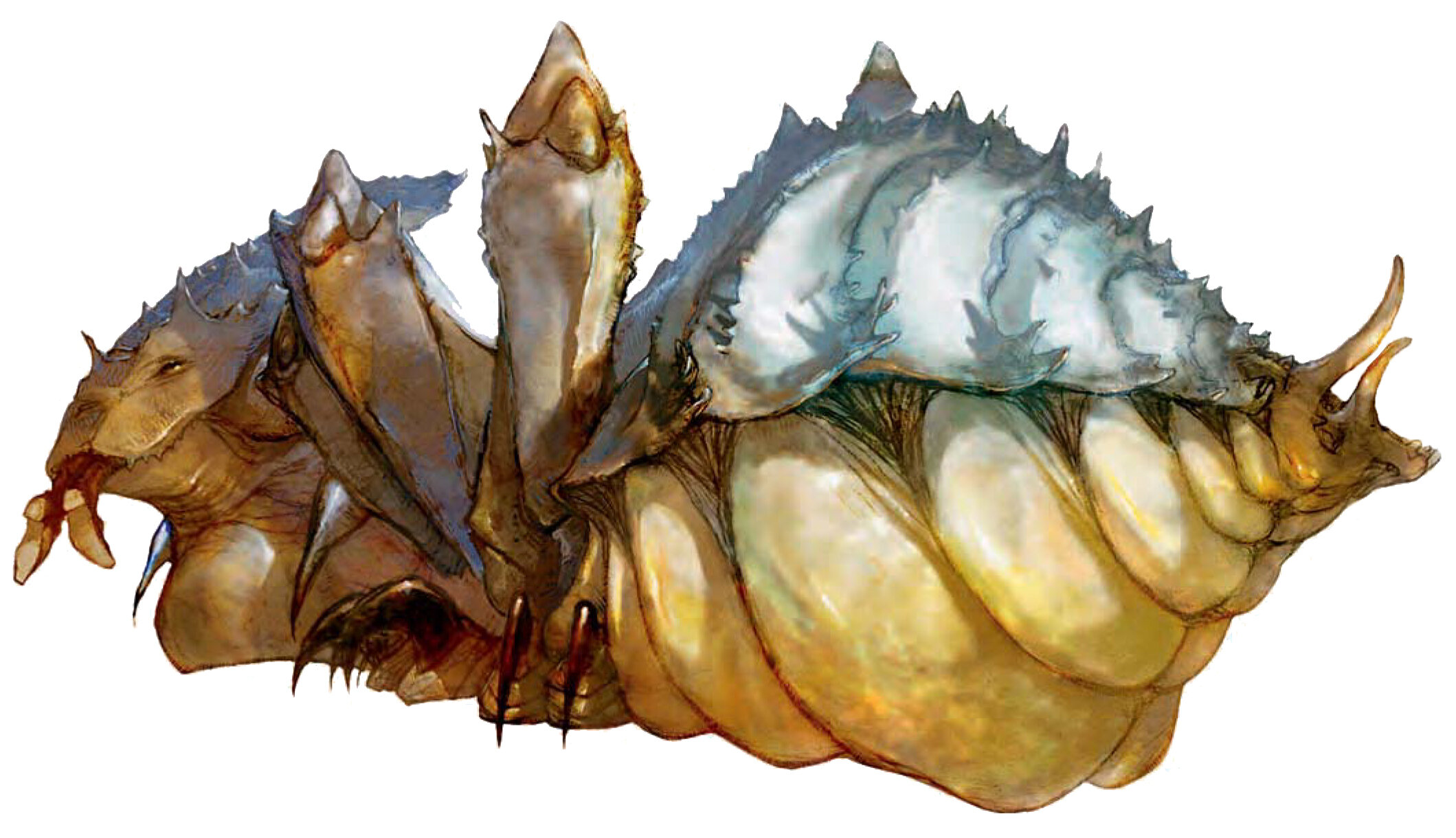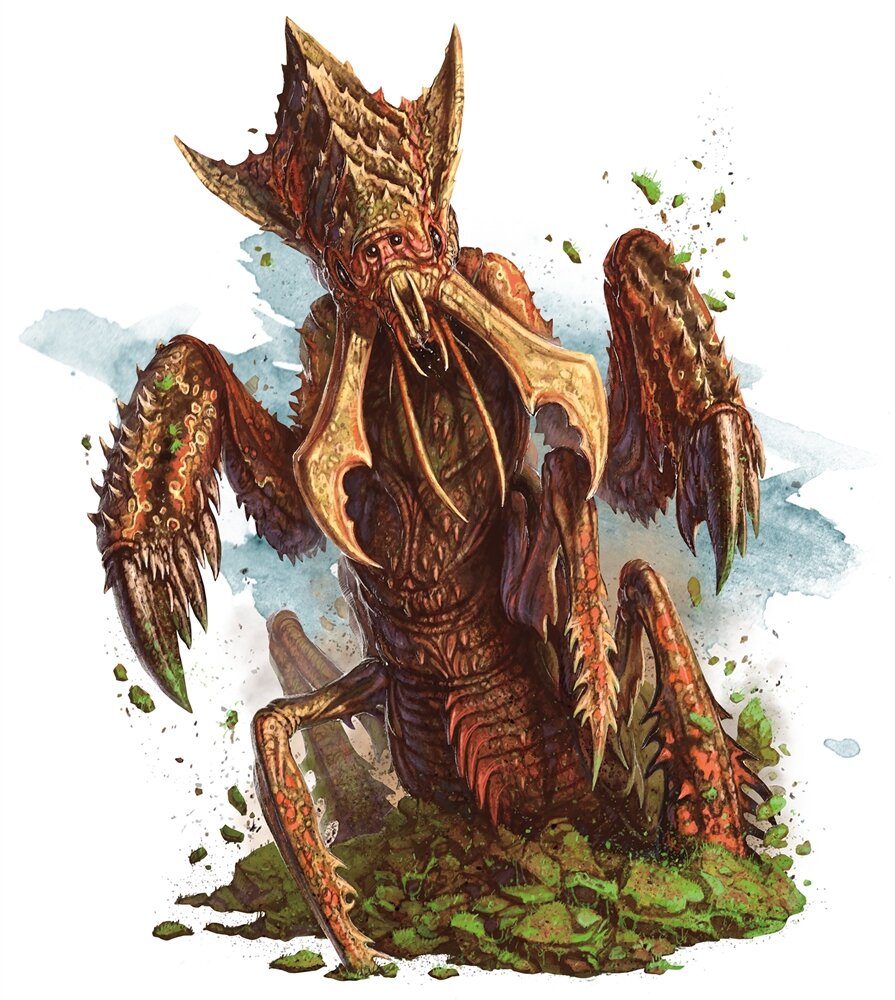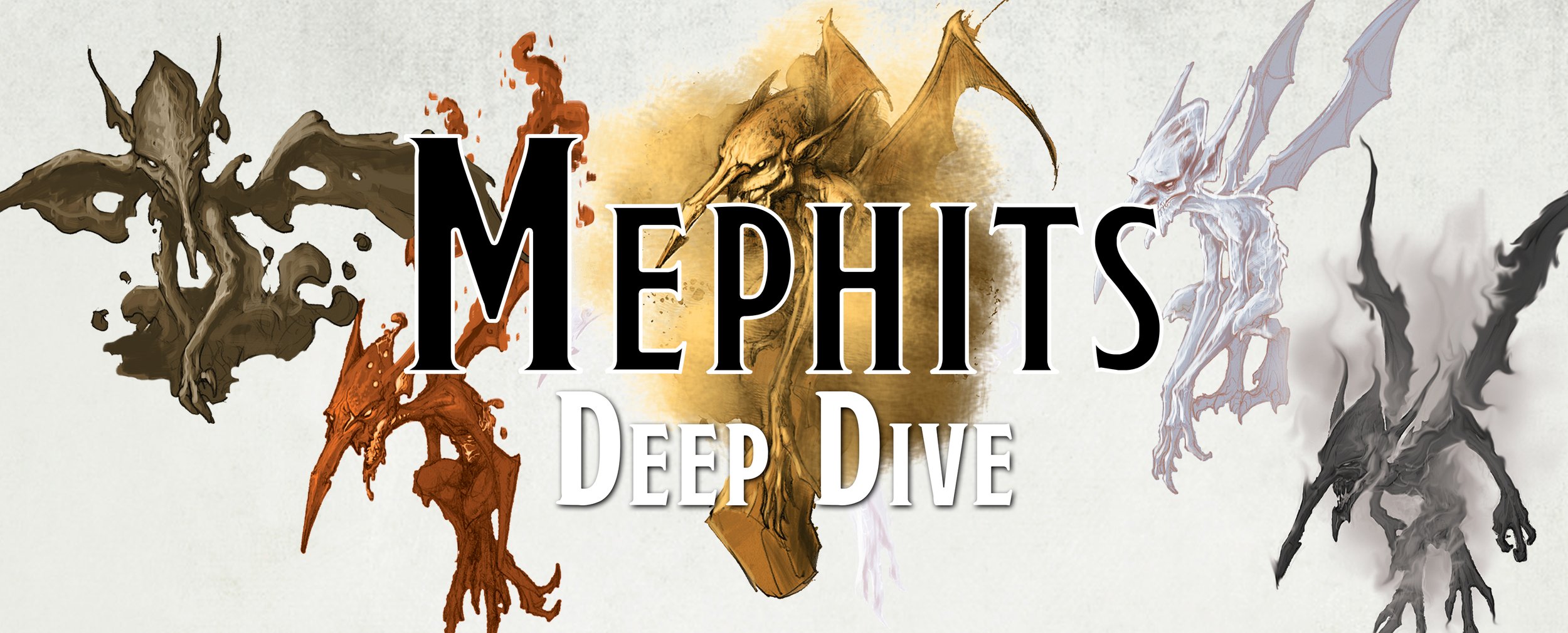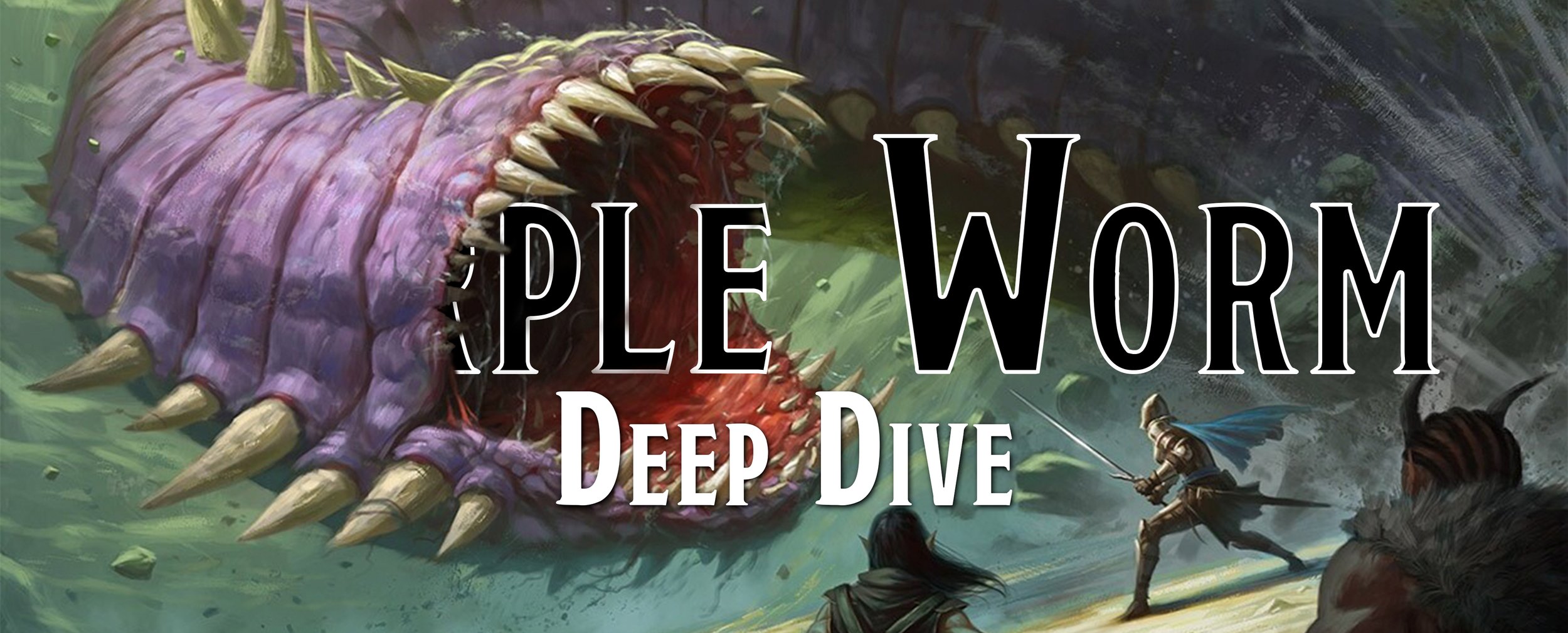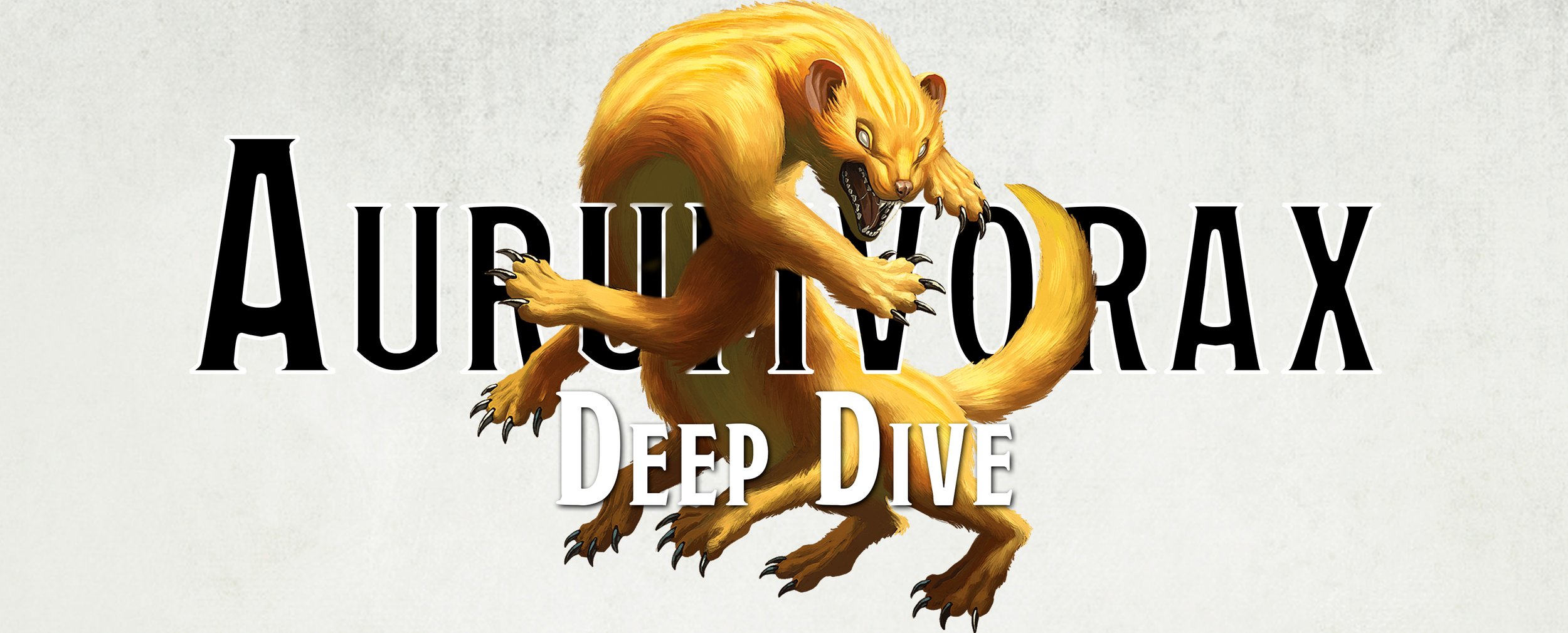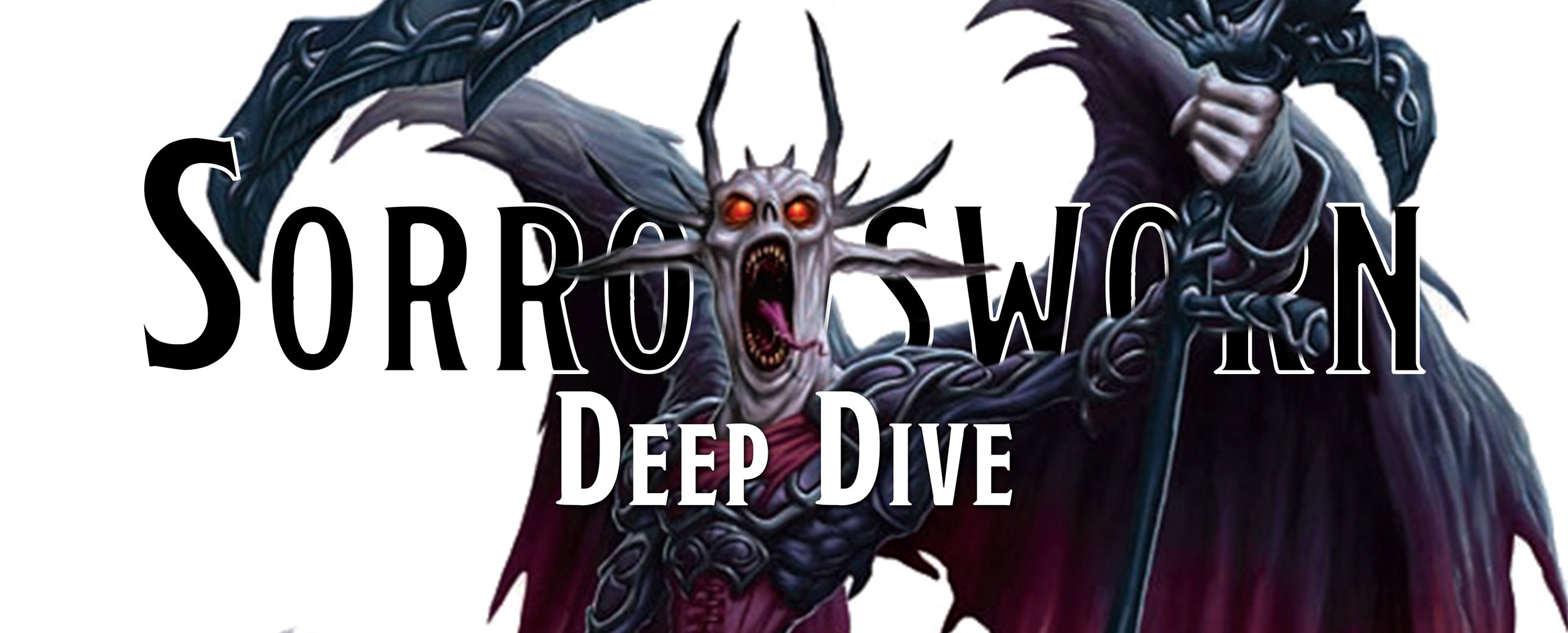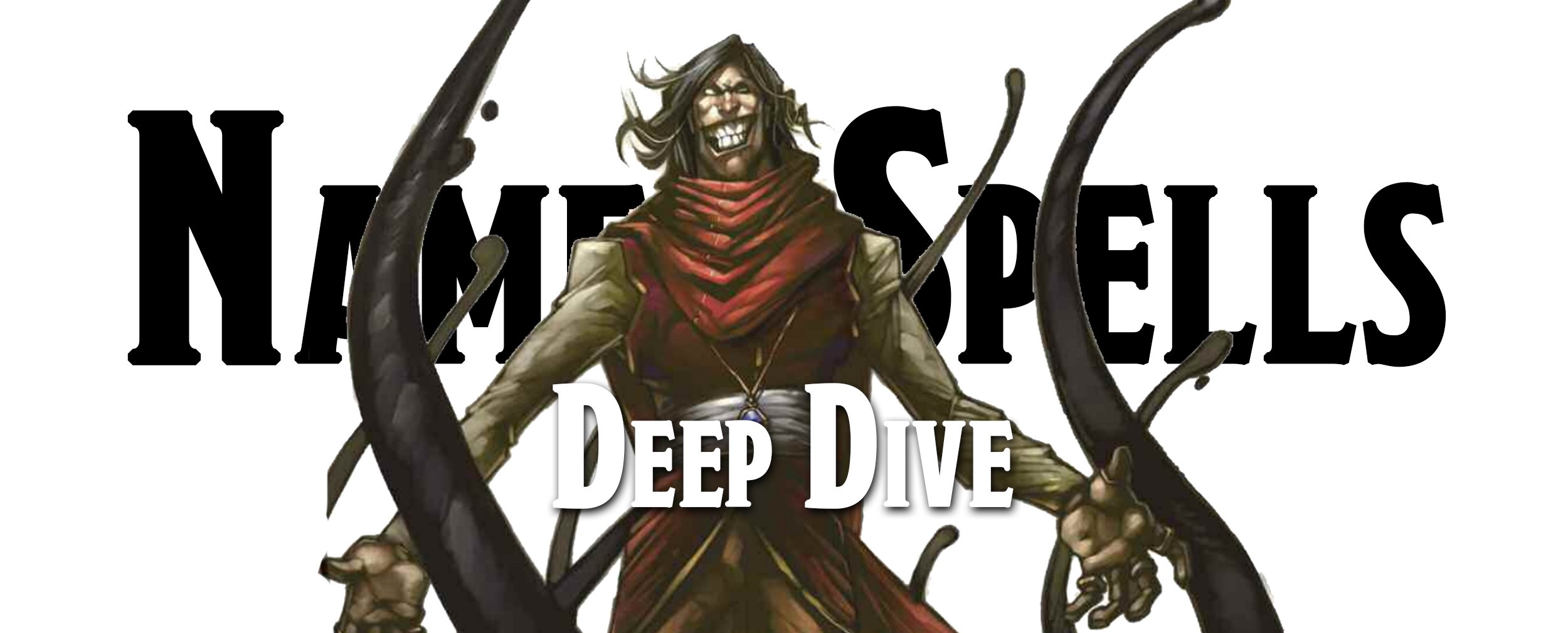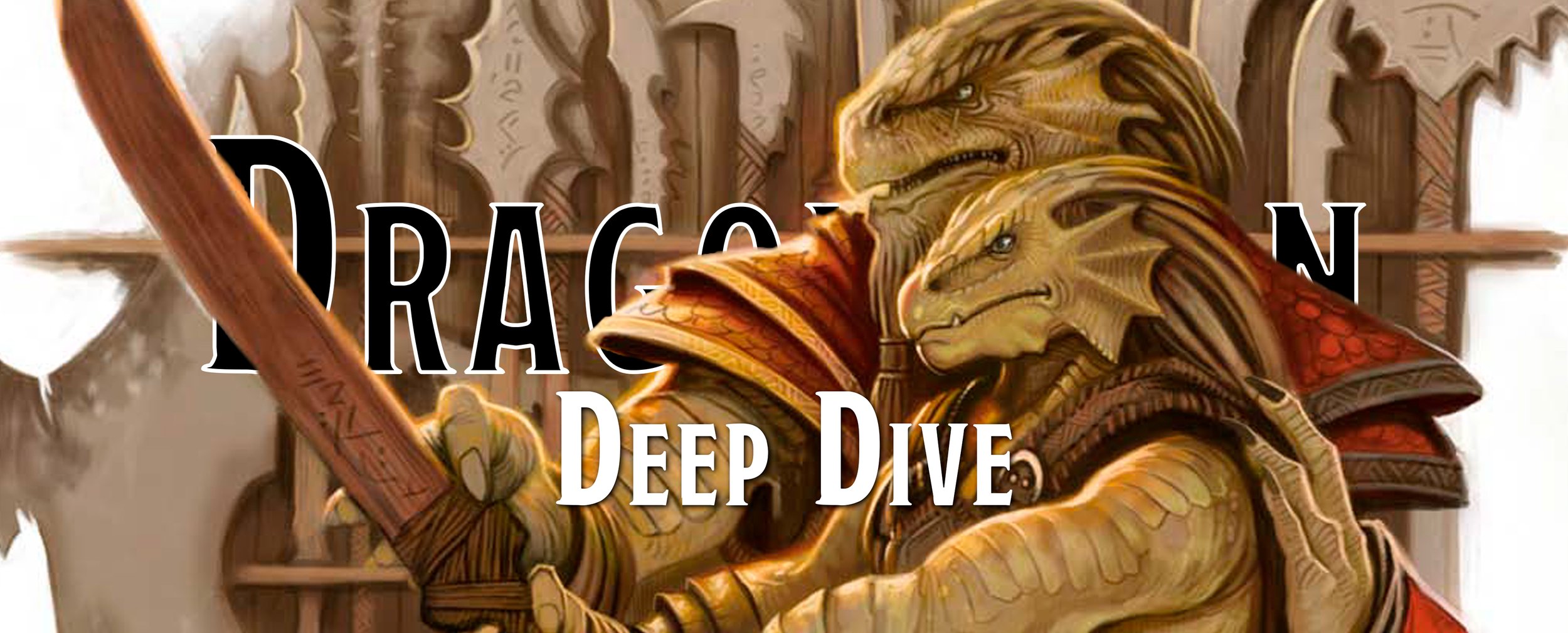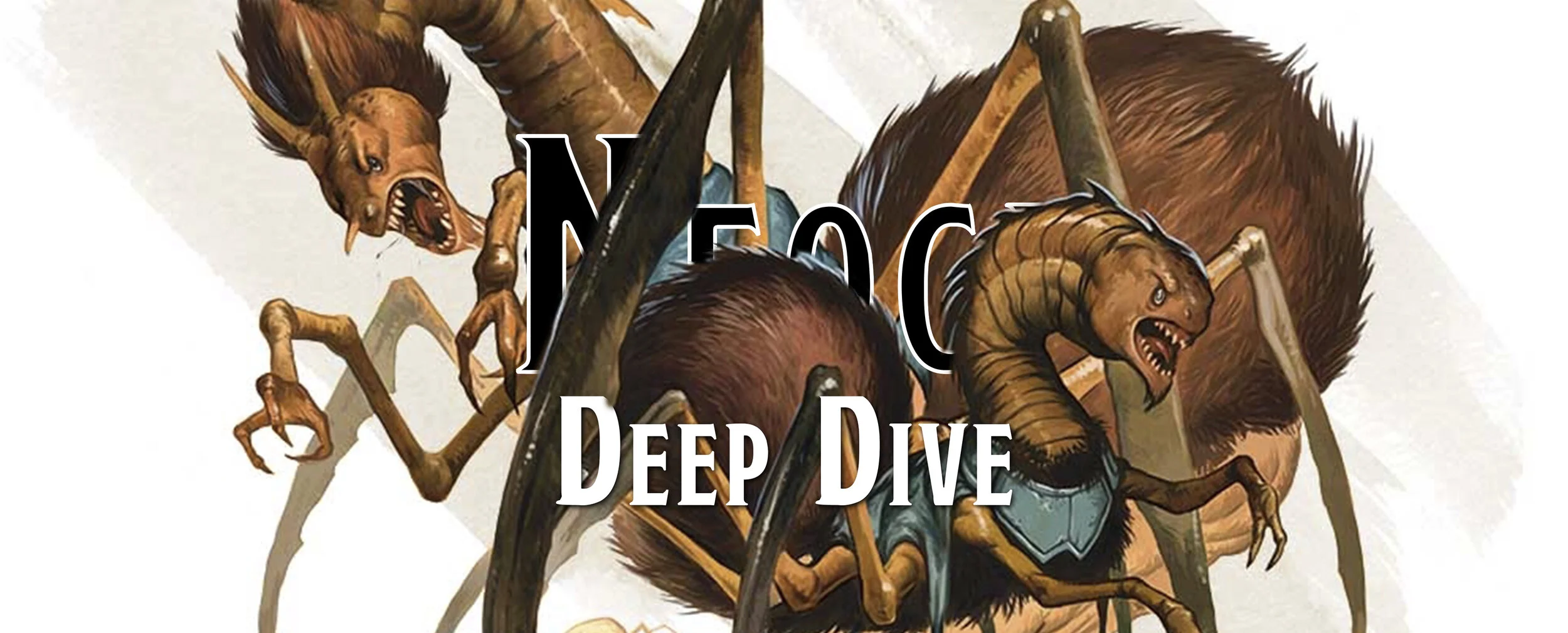Deep Dive - The Ankheg
While probably not the most exciting creature we’ve ever looked at, the Ankheg is still a ferocious monster that should be used in a campaign. While they may just be a threat for beginner adventurers, they are still quite nasty as few monsters can grab a creature in their powerful mandibles and then spray acid all over them, turning them into a rather disgusting pool of flesh. Ankhegs are what separates the fresh-faced adventurers from the veterans. If you can take down an Ankheg, then you might have what it takes to live the life of an adventurer.
AD&D - Anhkheg
Frequency: -
No. Appearing: 1-6
Armor Class: 2 overall, underside 4
Move: 12”/6” through ground
Hit Dice: 3-8
% in Lair: 25%
Treasure Type: B2
No. of Attacks: 1
Damage/Attack: Bite 3-18
Special Attacks: Acid (1d6 by size)
Special Defenses: -
Magic Resistance: -
Intelligence: -
Alignment: Neutral
Size: L (10-20’ long)
Psionic Ability: Nil
Monster Manual, 1977 TSR Inc.
The Anhkheg makes its first appearance in Dragon #5 (March 1977), later reprinted in the Monster Manual (1977), and is the featured creature in that issue of the magazine. Of course, featured is a bit of a stretch as it has a single paragraph of information on it but a full-page, colored image so that’s something. The Anhkheg, as it was originally spelled with an extra ‘h’ in its name, is basically a mole/worm insect creature that burrows through the earth. But unlike the mole, the Anhkheg survives on delicious soil, gaining its daily recommended vitamins and nutrients from it. Of course, a bit of tasty flesh, be it human or otherwise, goes great with dirt, so they add supplements into their diet when possible.
If you are unfortunate to face an Anhkheg, you’ll find yourself facing off against a giant-sized ant-centipede-insect thing. It has a dark brown exoskeleton, though its undersides are pinkish in hue, with large black eyes glistening with a hunger for flesh and dirt. It has powerful mandibles it can use to crush you to death, though luckily it can’t rip your flesh from your bones. Instead, it relies on its saliva to dissolve you so it can slurp you up. There’s no definite number of limbs specified, but based on the artwork, you have at least 6 pairs of legs to deal with, so you know this thing is horrible.
The Anhkheg's main way of attacking is hiding beneath about 5 to 10 feet of soil, and once it senses someone moving above them, springs out of the ground and ambushes them. It prefers to bite a creature, and thanks to some special enzymes, not only does its bite hurt a lot, but it also delivers acid as it tries to liquefy your body. If it realizes that its acidic saliva isn’t melting you fast enough or that its powerful mandibles can’t crush you in your fancy armor, then it can choose to spray all of its face-melting enzymes at you in a single acid spray. It can launch this acidic spittle up to 30 feet away, meaning if you think you are running away from this, think again. Luckily, it can only do this special attack once per six hours as it has to refill its internal reservoir, but unlucky for whoever just got hit, you are going to take up to 32 points of damage, which is… Well, your allies will thank you for your brave sacrifice as you turn into a pool of liquid flesh.
Dragon #005, March 1977 TSR Inc.
The Anhkheg is shown some love in Dragon #117 (January 1987) in the article Ecology of the Anhkheg by Mark Feil. The story is told from a minion of the Baron’s point of view, who is a wizard-poser. The wizard-poser is talking to a group of farmers whose land has been invaded by an Anhkheg and how the poser is regretting their life choices. We find out a great deal about the Ankheg and how they live, breed, and can be killed. The creatures still burrow, they can still detect tremors in the ground, and they still enjoy a tasty side of flesh along with their dirt à la mode. The sage, who has studied in a school of magic for several years but can’t cast magic themself, recommends appeasing the Ankheg with a couple of cows and goats, and while the farmers aren’t too keen on the idea, we think it’s a much better option than serving yourself up to the Anhkheg.
What new information is provided can be quite interesting, like they have the appearance, and much of the ecology, of prey mantises, except they burrow in the ground. When they choose to mate, a female Anhkheg will release an odor to attract a mate. This odor causes the male to get sleepy and confused but still is capable of fertilizing the eggs before the female rips its head off, which is one way to remove an Anhkheg, though it requires having more Anhkhegs. This typically happens at the end of fall, as the insect-like monsters hibernate during cold winters. This is when the eggs, which are implanted into the male’s corpse, will hatch and the babies will begin feasting on papa and any other carcasses that the mom has left behind for them to eat while she sleeps through winter - which is a parenting style we can’t recommend.
So let’s say you actually want to get rid of the Anhkheg before it begins creating more of itself. Well, Anhkhegs have a huge weakness in their armor, and no it isn’t their underside which is only slightly weaker than their back shell. Anhkhegs must shed their shell before they hibernate for the winter, which leaves them vulnerable to attack for about a week. When it does so, it releases a horrid odor that smells of rotting fruit, which is meant to drive away natural predators but can be quite attractive to adventurers and farmers looking to slay.
If you do happen to kill an Anhkheg, their remains can be used for a wide variety of purposes. While it doesn’t specify if they taste good, you could probably eat them like a crab or lobster, and then use their chitinous armor as plate armor or weapons. This can be great for the poor farmer whose Baron didn’t bother with destroying their Anhkheg problem, making them realize that maybe, just maybe, they shouldn’t have to pay taxes to the lazy noble who won’t get off their ass to help them in their time of need.
Dragon #117, January 1987 TSR Inc.
2e - Ankheg
Climate/Terrain: Temperate and tropical/Plains and forests
Frequency: Rare
Organization: Brood
Activity Cycle: Any
Diet: Omnivore
Intelligence: Non- (0)
Treasure: C
Alignment: Neutral
No. Appearing: 1-6
Armor Class: Overal 2, Underside 4
Movement: 12, Br 6
Hit Dice: 3-88
THAC0: 17-13
No. of Attacks: 1
Damage/Attack: 3-18 (crush) + 1-4 (acid)
Special Attacks: Squirt acid
Special Defenses: Nil
Magic Resistance: Nil
Size: L-H (10’ to 20’ long)
Morale: Average (9)
XP Value: 175-195
Monstrous Compendium Volume 2, 1989 TSR Inc.
The Ankheg, now with only a single ‘h’ in its name, appears in the Monstrous Compendium Volume 2 (1989) and is reprinted in the Monstrous Manual (1993). The creature’s favorite pastime is still burrowing under farmlands and supplementing its diet of dirt with tasty flesh. While the description doesn’t specifically state that the Ankheg eats the soil to gain the nutrients it needs to survive, it does specify it likes to roam 10 to 40 feet below the surface, until it has depleted an area of nutrients. Some might take that to mean that it eats roots, soil, and tubers while others might think depleting the area involves eating every single living creature that it can reach, like farmers, cows, and even cute squirrels that were brave enough to wander along the ground. Despite this, there might be a reason why you wouldn’t kill an Ankheg immediately as having one under your farm may not be good for your health, but it is good for the farm. The Ankheg’s tunnel system provides the soil with passages for air and water, and the creature’s waste adds many nutrients to the ground. Who knew the best fertilizer was farmer dung?
Their description is slightly changed in this edition, with them being described more as a worm-like creature with six pairs of legs and a head with powerful mandibles. These powerful mandibles can bite through a tree, or you, in a single chomp. Of course, you have more than the chomp to worry about as its mandibles excrete a quick-acting acid that eats away at even metal and stone, as it kind of has to if it wants to burrow through the soil.
Monstrous Manual, 1993 TSR Inc.
The Ankheg’s mandibles are primarily used to dig its tunnels under the farmlands where it resides. Why farmlands? The Ankheg loves soil filled with healthy nutrients, and a farmer that doesn’t care for the ground isn’t going to be a farmer very long. The tunnels end in a makeshift lair for the creature, live, eat, and call a male to come and get nasty in the dirt. It’s still a short-lived relationship, as the female still kills the male after the eggs are fertilized. Those eggs are deposited into the dead dad’s body, where they will hatch in a month. Once the Ankheg has gobbled up all the yummy dirt, it will move onto the next farm or fertile land and repeat this process all over again.
The Ankheg’s exoskeleton remains hard as stone, with the creature’s underbelly only slightly weaker, so knock it prone and bring a pickaxe. Their shell is brown or yellow, and it has black as night eyes, nasty oversized mandibles, and two antennae. It’s these antennae that give the Ankheg its ability to sense when someone is walking above it, able to notice delicious farmers up to 300 feet away.
The Ankheg still has its deadly acidic spittle, though it prefers to just chomp and excrete it on you then. It takes 6 hours for it to eat again, and so just spraying its digestive fluids everywhere can really put a damper on its end of the fight celebrations when it has to wait until it can eat, and by that time, the farmer has gone cold and is it really any good to eat at that point?
3e/3.5e - Ankheg
Large Magical Beast
Hit Dice: 3d10+12 (28 hp)
Initiative: +0
Speed: 30 ft. (6 squares), burrow 20 ft.
Armor Class: 18 (–1 size, +9 natural), touch 9, flat-footed 18
Base Attack/Grapple: +3/+12
Attack: Bite +7 melee (2d6+7 plus 1d4 acid)
Full Attack: Bite +7 melee (2d6+7 plus 1d4 acid)
Space/Reach: 10 ft./5 ft.
Special Attacks: Improved grab, spit acid
Special Qualities: Darkvision 60 ft., low-light vision, tremorsense 60 ft
Saves: Fort +6, Ref +3, Will +2
Abilities: Str 21, Dex 10, Con 17, Int 1, Wis 13, Cha 6
Skills: Climb +8, Listen +6, Spot +3
Feats: Alertness, Toughness
Enviroment: Warm plains
Organization: Solitary or cluster (2–4)
Challenge Rating: 3
Treasure: None
Alignment: Alaways neutral
Advancement: 4 HD (Large); 5–9 HD (Huge)
Level Adjustment: -
Monster Manual, 2003 WotC
The Ankheg is found in the Monster Manual (2000/2003), and one has to wonder how a monster gets chosen for the first Monster Manual. This isn’t us disparaging the mighty Ankheg, especially if there is one nearby, but rather we have had several fascinating creatures not make it into the first round of monsters that are far more interesting and iconic. Despite that, the Ankheg is still a burrowing monster that will leave most farmers terrified and seeking out a group of adventurers willing to work in pest control.
Ankhegs still like to burrow, though now they don’t leave behind tunnels unless they want to, which is how they set up their temporary nests before migrating somewhere else. Oddly enough, clusters of Ankhegs can reside in the same territory but don’t cooperate, instead, they simply attack when they want with little regard to the others near them. If multiple do attack at the same time, they’ll do their own thing, attacking different victims unless there isn’t enough to go around, in which case they’ll play tug of war with the farmer’s body, ripping it in half as they try to get the biggest chunk.
The Ankheg’s primary attacks remain its ability to bite with its powerful mandibles, and never let go, as well as spitting acid. The countdown on spitting acid still remains at 6 hours, but the exciting part is that it now shoots acid in a 30-foot line, meaning it is going to hit far more people than it did previously. While this is an attack of last resort, or if it is frustrated with the farmer who refuses to go down, it definitely feels more dangerous to have it triggered as it can hurt multiple people at once.
Monster Manual V, 2007 WotC
The last bit of excitement for the Ankheg comes in the Monster Manual V (2007) which brings forth what happens when Ankheg eggs get a bit of eldritch energy in them. The Mockery Bugs are descended from Ankhegs the same way that chuul are descended from lobsters. These horrific bugs are led by a Mockery Monarch, who are only formed very rarely from Ankheg eggs and are completely sterile. The Mockery Monarch can produce Mockery Drones, which appear like any humanoid that the Mockery Monarch consumes. The monarch then sends her drones out into the world to try and convince outsiders to come visit her so that she can continue to feed and make even more drones. She appears as a rather rotund Ankheg without the horrible mandibles.
Monster Manual V, 2007 WotC
Mockery Drones are born after their monarch consumes a humanoid and they are spawned looking exactly like the humanoid, except they have an idiotic smile permanently on their face. They are rather dumb, and can easily get overwhelmed or frustrated when it comes to talking or doing anything more complicated than walking in a straight line. If they are trying to convince a group of adventurers, or farmers, to follow them to unknown locations, these new experiences can easily overwhelm them, causing them to repeat their sentences constantly or act strangely, like walking into walls or making odd noises. If they feel like their victims are starting to get suspicious, they’ll simply explode out of the humanoid form they have, appearing as a long centipede with the head of whatever humanoid they were trying to pass off as. The goal of all drones is to feed their monarch and, while they are about as smart as a bag of rocks, they are powerful and have no problem just delivering a corpse to their monarch.
4e - Ankheg
Large natural beast
Level 3 Elite Lurker
Initiative +10
Senses Perception +9; tremorsense 5
HP 100
AC 17; Fortitude 14, Reflex 16, Will 14
Resist 5 acid
Saving Throws +2
Speed 8, burrow 4 (tunneling)
Action Points 1
Claw (standard; at-will) +8 vs. AC; 1d8 + 5 damage.
Mandible Grab (standard; usable only while the ankheg does not have a creature grabbed; at-will) +8 vs. AC; 1d8 + 5 damage, and the target is grabbed; see also mandible carry.
Gnaw and Scuttle (minor; at-will) ✦ Acid Targets a creature grabbed by the ankheg; +8 vs. AC; 1d8 + 2 damage, and ongoing 5 acid damage (save ends). The ankheg then shifts 2 squares and pulls the target to space adjacent to its new location
Acid Spray (standard; recharges when first bloodied) ✦ Acid Close blast 3; +8 vs. Refl ex; 1d8 + 5 acid damage, and the target is slowed and takes ongoing 5 acid damage (save ends both).
Mandible Carry An ankheg can move at normal speed while carrying a creature that is Medium or smaller.
Alignment Unaligned / Languages -
Skills Stealth +11
Str 15 (+3) Dex 20 (+6) Wis 16 (+4) Con 18 (+5) Int 2 (-3) Cha 4 (-2)
Monster Manual 2, 2009 WotC
The Ankheg appears in the Monster Manual 2 (2009) along with its babies who just can’t wait to sink their mandibles into you. While little changes, the Ankheg still burrows and attacks from below, and still desires flesh to supplement their diet of dirt, there is still some new information to glean. The first thing that jumps out to us is that male Ankhegs aren’t simply killed and used as a warm place for baby eggs. Now Ankhegs like to travel in pairs along with their broodlings that they take care of by killing monsters and dragging the corpse over for a family picnic.
They still appear as insect-like monsters, like ants, and you’d think they’d get along since they have so much in common… like being an insect or digging tunnels or just freaking us out because they are horrific to look at. So much in common, and yet they still have disagreements. Giant ants, the size of a large dog or a human, will gather up together and then kill the Ankheg adults, but keep the broodlings alive. The broodlings will be bullied by the giant ants and forced to do giant ant bidding, which is probably the exact same thing that their parents would want them to do, which is dig some tunnels and stop playing so many video games and go outside for once!
Ankhegs still behave in a fight like normal, waiting to burst from the ground, grab onto something to eat with its mandibles, and try to carry it away where it can eat its melting flesh pool in peace. The most exciting thing for Ankheg adults is that they can now spray their acid in a short cone and not only just once per 6 hours! They can spray their acid once, and then when you reduce them to half their hit points, the Bloodied value, their spray automatically recharges and they get a second chance at just melting your face off so they can slurp it up in their mandibles.
If that doesn’t excite you, well then the Ankheg Broodlings could be for you. They are weaker than the adults, no surprise there, but gain bonuses to their attack if their parents have a victim grappled. They crawl all over you and start tearing out big pieces of delicious you, and if they happen to score a critical hit, they spray acid all around like a baby sprays mashed peas everywhere. Frankly, it’s quite adorable… except for the anguished screams of the farmer who was just minding their own business.
5e - Ankheg
Large monstrosity, unaligned
Armor Class 14 (natural armor), 11 while prone
Hit Points 39 (6d10+6)
Speed 30 ft., burrow 10 ft.
STR 17 (+3) DEX 16 (+0) CON 13 (+1) INT 1 (-5) WIS 13 ( +1) CHA 6 (-2)
Senses darkvision 60 ft., tremorsense 60 ft., passive Perception 11
Languages -
Challenge 2 (450 xp)
Bite. Melee Weapon Attack: +5 to hit, reach 5 ft., one target. Hit: 10 (2d6 + 3) slashing damage plus 3 (1d6) acid damage. If the target is a Large or smaller creature, it is grappled (escape DC 13). U ntil this grapple ends, the ankheg can bite only the grappled creature and has advantage on attack rolls to do so.
Acid Spray (Recharge 6). The ankheg spits acid in a line that is 30 feet long and 5 feet wide, provided that it has no creature grappled. Each creature in that line must make a DC 13 Dexterity saving throw, taking 10 (3d6) acid damage on a failed save, or half as much damage on a successful one.
Monster Manual, 2014 WotC
The Ankheg appears in the Monster Manual (2014) and it carries on the proud tradition of looking like a giant insect ready to bite your face off and dribble some acid on you. It appears like a dark brown praying mantis on steroids, with strange spikes shooting out all over it, which is odd for a creature that burrows through the ground. You’d think it’d be a bit more streamlined so its head, shoulders, and body weren’t constantly getting caught on rock outcroppings.
If you are hoping to find one of these creatures, maybe because you heard you could make armor out of their chitinous exoskeleton and want to become known as the bug knight, well good news! They can still be found hanging out in forests and farms where the most fertile soil is located… and also where delicious people, cows, pigs, and game can be found. They still supplement their diet with flesh, using their digestive enzymes to dissolve their victims cause they are like any toddler who refuses to chew food for more than a single bite and instead wants everything in milkshake form.
The biggest change for the Ankheg is that their acid spray no longer takes 6 hours to recharge, but instead they can spray acid out about once every 6 rounds, which is about every 36 seconds. That’s a pretty big change for them, just as your body will go through a pretty big change after you are hit with a 30-foot long line of acid that begins turning you into a puddle. Since there is no mention about having to wait for their acid to recharge to gorge itself on the farmer milkshake, we can safely assume that that means they can go ahead and start eating right away. This is only a nice change for the Ankheg and no one else as they run away in terror and just hear horrific slurping noises.
The Ankheg is an ambush predator and the bane of all farmers and starting adventurers. Sadly for Ankhegs, they aren’t much of a threat for veteran warriors, especially since they aren’t very fond of each other and prefer being left alone. For insects, they are ferocious and cruel, destroying all before them and many can agree that they have earned the dubious honor of being known as the Farmers’ Bane.







